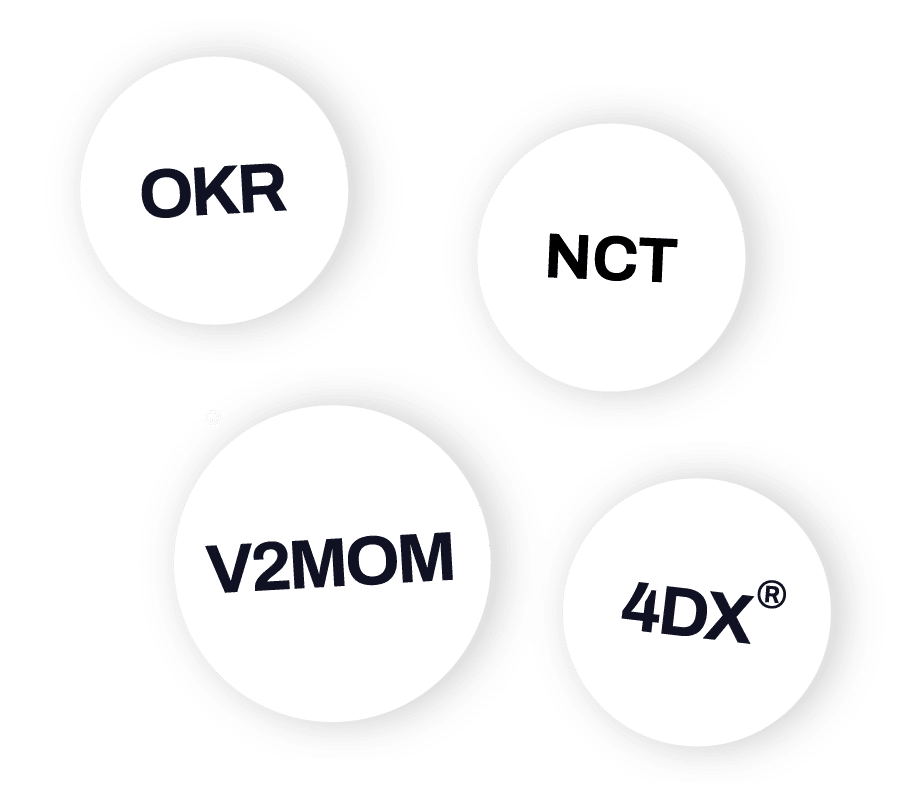OKRs Implementation Tips That Solve Common Mistakes & Issues
We are huge OKR fans, and we help companies manage OKRs in ZOKRI and we coach OKR. But if better goal setting and an increased likelihood of goal achievement is the whole point of OKR, we have found that there are things you can do to make OKRs easier for everyone to adopt and use correctly.
Key Result is a ‘good’ label for the measurement part of and OKR. During implementations we found another that actually might be better
We have found that by giving companies the option to change the term “Key Results” to a few other choice or anything they like, most would stick with Key Result. It turns our that “Success Measures” is popular. Who knew?
So we went deeper to find out more and it looks to have helped to address some of the concerns and criticisms associated with OKRs. How you might ask?
The term “Success Measures” emphasizes the idea that these metrics are meant to evaluate the success of the objectives, rather than solely focusing on quantifiable outcomes. This subtle shift in terminology can help organizations consider a more holistic approach to defining and evaluating their goals.
By using “Success Measures” instead of “Key Results” it has resulted in improvements in the understanding of what is required and better quality “Key Results” being written! So do we just call Key Results Success Measures?
Top 10 OKR Implementation Mistakes & Challenges Solved By ZOKRI
- OKRs not Strategic, often BAU
- Lots of OKRs frequently getting missed
- Low engagement and low OKR affinity
- Tasks not outcomes as Key Result
- OKR executional processes under invested
- Confusion over role of OKRs and KPIs
- OKR seen as complex and confusing
- Org. chart OKRs only being used
- OKR meetings seen as poor use of time
- Rituals that support OKR achievement not followed
What us going on?
-
Broader focus on performance
By emphasizing success rather than strictly quantifiable results, you are able to consider a wider range of factors that contribute to success like blue-sky thinking, learning and process improvement goals.
-
Flexibility in measurement
The term "Success Measures" suggested that you can be more flexible and creative in how you measure the achievement of objectives, allowing for the use of learning and qualitative metrics - this is a great best-practice!
-
Enhanced communication
Using "Success Measures" has helped teams to better communicate the intent behind OKRs, emphasizing the focus on overall success rather than just hitting specific numerical targets.
With ZOKRI you can use the term Key Result, Success Measure or any other variant your choose.
Now that the can of worms is open, can you go further and make OKRs even better? 👀
If we’re open to change, let’s ensure “Objectives” are paired with a “Narrative”?
We’ve often found that simply having a short Objective field often does not communicate the story of what a goal is trying to do and why a goal was chosen.
These narratives are important for other people reading about the goal. Context is everything with goal setting, especially where widespread goal transparency being practiced.
This has been borrowed from the learnings of the NCT (Narrative, Commitments and Tasks) framework that has found benefits in encouraging a full goal narrative explaining the ‘what’ and ‘why’ behind a goal.

OKRs are not perfect and can borrow from ideas from other goal frameworks
Now lets make the planning of “Commitments” or “Tasks” a integral and mandatory part of the goal setting process
Instead of focusing solely on the final “Key Results” or “Success Measures”, we have found the need to introduce the concept of “Tasks” or “Commitments” to monitor the ongoing progress towards achieving success measures.
This does a few important things.
- You can inspire and gather great ideas on things you could do to achieve your goal – from known to work tasks to experiments that might unlock new potential
- It makes even the hard goes feel more achievable
- You get more buy-in to the outcome you’re trying to achieve
- You build more goal resilience
- You maintain momentum and motivation
- You can enhance progress tracking and identify any potential issues or obstacles early on
Let’s not invent another goal acronym, because, KISS works 🙌
We could easily end up creating acronyms like: Purpose, Success Measures and Comittents (PSC) or Purpose, Success Measures and Commitments (PSMPI) are not going to help managers and employees.
Would it be better to call these Goals not OKRs? And then use Input labels like those above?
If we were trying to work in a way where anyone and everyone in a company could pick up what was required of them and then use that knowledge to help the company, team and themselves to perform, would we go full KISS mode?
Are KISS goals better?
“KISS, an acronym for “Keep it simple, stupid!”, is a design principle noted by the U.S. Navy in 1960. The KISS principle states that most systems work best if they are kept simple rather than made complicated; therefore, simplicity should be a key goal in design, and unnecessary complexity should be avoided.”
-
Goal
The high level concept of describing a future desirable outcome.
-
Objective
A description of what the goal is and why you’ve decided to focus on it and resource it.
-
Success Measures or Key Results
How you know you have successfully achieved your goal that can be performance, learning outcomes or strategic projects.
1 -3 of these is ideal
-
List of Commitments
The work that if done would lead to the successful achievement of the goal. These could be tasks that are completed. A number of things are done e.g. make 10 calls a day, or an experiment / hypothesis e.g. we want to try a new approach to something that acts as a lever on performance.
In ZOKRI you can use OKR, any other framework
or choose your own KISS labels.
Last recommendation: Centralize goal setting in a software platform that ensures goals are achieved, not just set well. Otherwise what’s the point!
How far can we push OKR and move it from a goal acronym, that’s frequently poorly used, to an easy to adopt goal framework that values achievement as much as a goal description?
What else would we do in order to ensure we benefit from what OKRs are trying to do, avoid the pitfalls teams often encounter and always set great goals and then stay focused, motivated, agile and enjoy each goal cycle.
Before we get stuck in, it is worth noting that OKR coaches work hard to ensure all of this is understood and adopted, but it’s not a natural part of OKR and the achievement system, rituals and habits are often what’s missing from a DIY-adoption plan.
Emphasize learning, growth and reinforce healthy behaviours
Encourage a culture of continuous improvement and learning by incorporating regular reflection, feedback, and adaptation into the OKR process. This can help organizations and individuals learn from both successes and failures, fostering a growth mindset and ongoing development.
ZOKRI has made the retrospective a feature that can be enabled at the goal or commitment level. This valuable step makes learning part of the goal setting cycle.
We have also learned that being upfront on the company and team values and behaviours need to align with high-levels of performance. So we built features that allow you to communicate and reinforce these via feedback, endorsements and praise.
Enhance collaboration and cross-functional alignment
Strengthen the focus on collaboration and alignment between teams by incorporating joint or shared OKRs where appropriate. This can help break down silos, improve communication, and ensure that everyone is working towards the same goals.
ZOKRI has systems and processes to ensure teams can collaborate on the creation of goals, share goals and if required create project teams dedicated to the achievement of a goal.
Prioritize quality over quantity
Limit the number of OKRs per individual or team to maintain focus and avoid spreading resources too thinly. By prioritizing a few high-impact objectives, organizations can concentrate their efforts and drive meaningful progress.
Needless to say, this is another goal setting best-practice that can be supported in ZOKRI.
Don’t encourage, insist on regular update and meeting with a recurring execution focused agenda
Establish a consistent cadence of check-ins and updates to discuss progress, share learning, address any issues or obstacles and set priorities.. This can help keep everyone aligned, engaged, and accountable for their OKRs.
Another USP of ZOKRI is its ability to manage these meetings with ZERO preparation time for sides and spreadsheets needed.
It works! We are privileged to see it in action. ✅
We’ve seen first-hand that by incorporating these adjustments and evolving the terminology and best practices of the OKR framework, organizations can further align the framework with goal achievement and drive better results.
Of course, changing the terminology alone is never going to be sufficient to address all the concerns associated with OKRs.
Organizations need to ensure that they have clear communication, alignment, and ongoing monitoring and adjustment of the OKR process to mitigate potential issues. This includes providing adequate training and support to employees and managers, fostering a culture of collaboration and adaptability, and regularly reviewing and revising objectives and success measures to ensure continued relevance and effectiveness.
However, it is important to remember that each organization is unique, and adjustments to the OKR framework should be tailored to fit the specific needs, culture, and goals of the organization.
With ZOKRI, you can use OKR or any other framework you choose, and you can change your mind if there’s something better out there, without changing software.
It’s whatever works best for you.
One of ZOKRI’s many USPs is its ability to allow companies to choose their preferred way of labeling goal entities as well as the supporting concepts and executional steps and rituals you want people to follow to execute against them.
BETTER GOAL SETTING
- Mission, Vision, Purpose
- Strategy
- Framework Implementation e.g. OKR
- Aligned Executional Steps
- Automated Progress Updates
- KPI Scorecards
FOCUSED EXECUTION
- Progress Checkins
- Issue Collection & Management
- Priority Setting & Sharing
- Meeting Management
- Notifications & Alerts
- Manager Support & Reporting
CULTURE MANAGEMENT
- Share Values & Behaviours
- Reconize & Reward
- Stream Feedback & Build Buzz
- See League Tables
- Spot & Address Problem Areas
- Integrate With HR Processes
- United Kingdom
Ashtead
KT21 1RZ
+44 20 7046 1328

- United States
New York
NY 10013
+1 646-718-4720
- ZOKRI helps leaders and teams achieve strategic goals using the OKR (Objectives & Key Results) framework. Our platform aligns strategy, goals, and people, fostering engagement and growth through comprehensive training and management systems.
© ZOKRI 2025 All rights reserved | Privacy Policy | Terms & Conditions | GDPR
Contacts Us
Tell us what you need. We'd be delighted to help.
"*" indicates required fields